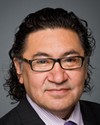Mr. Speaker, it is a privilege for me to stand this afternoon and speak to Bill S-8.
I have the privilege of serving as the chair of the aboriginal affairs and northern development committee. I note, Mr. Speaker, that it is a role you undertook prior to your current position, and it is a privilege to succeed you in that role.
It has been a privilege to serve as chair amid the relationships that have developed across party lines, and I believe our committee has been able to undertake some good work. We have been able to do that in a way that respects not only the desire to bring different perspectives together but to move things forward. It has been a privilege for me to serve in this capacity, and I owe a debt of gratitude to all committee members of all parties who have worked together.
In the consultations and work we did in reviewing Bill S-8, that relationship was paramount, because we desired to hear from folks from different locations across the country. We desired to hear from first nations as well as experts, and from municipalities in addition to that. We desired to hear from people who could speak to the issue of drinking water on reserves specifically, and how we might move toward safe drinking water for all first nations communities and for all first nations people across the country.
There has been much said already about the bill, some of which I agree with and some of which I do not. However, this piece of legislation is enabling legislation. It will allow for regulations to be created to ensure that the water every first nation is using and providing to their local grassroots members is safe.
Clean, safe drinking water is something that we all, as Canadians, take for granted. Water in most municipalities and water systems is provincially regulated, and we know that the regulations that have been established do provide assurance of cleanliness and safety. However, this is not the case in first nations communities. I wanted to note that off the top.
One of the privileges that I have had as well is to serve with the member for Medicine Hat on these important issues. I will be sharing my time today with the member from Medicine Hat.
An important thing to note with regard to this legislation is that some people have asked for additional clarity or for provision of what the regulations would look like once they are done. We recognize as a government—and I think our minister and the minister before him have articulated it well—that it is important that we do not create, or try to create, a one-size-fits-all approach. First nations across the country were loud and clear that one size does not fit all. It never will and never has, for a number of reasons.
Number one, there are differences in our geography in terms of where water comes from, in terms of the number of people it serves and in terms of the technologies available.
There are also differences in what has been undertaken by different municipalities and different provinces. Often first nations communities depend on or collaborate with neighbouring municipalities, so if a set of regulations in one province is different from the regulations in another province, yet they both comply with their respective provincial regulations, then to try to manufacture a national, pan-Canadian regulation system would not take in the differences that we should all accommodate.
Just because there are different regulations does not mean there are different levels of water quality. Different regulations are often required because of different hydrology or different sources of water that local people are drawing from, as well as a result of the number of people who live in certain areas. A water system that serves 100 people or 25 people is vastly different from a water system that supports tens of thousands of people.
That is the reality in municipalities. It is also the reality in first nations communities. That is why an enabling piece of legislation would allow flexibility to work with first nations, to respond to their desires and hopes but also to the realities within their communities. I think we all want a system that will work and provide assurance for clean drinking water into the future.
Our government has invested significantly in providing clean drinking water. I can say that in my own constituency, we have seen significant amounts of money allocated toward water systems that provide water to first nation communities. In some cases, these water systems have been set up to be separate and only for first nation communities. In other cases, we have collaborative efforts that have been undertaken between first nations communities and neighbouring municipalities. The water systems that are built are different because the needs are different and because the water sources are different. However, I can say that with the money that has been leveraged into these systems, many first nations throughout my constituency are being better served with cleaner water and the assurance of that.
However, if we build these systems without regulations, we know that there is a possibility we cannot be assured that the people who are running these systems are trained to run them, and we heard testimony of that at committee. We heard again and again of the necessity of ensuring that for the water systems. All the money in the world could be spent on a water system, but if there is no one running it who knows how to do so, there is a chance that these systems will fall into disrepair, or as a result of either flooding or some type of change in the source water, there may be contamination or problems in terms of the water. Therefore, it is important that we have trained folks, and that is what regulations would set out. Obviously they would ensure that the people who should be running these systems are doing so.
As we look across this country, we see significant diversity. When we look at it region by region, we know we will have to be responsive not only to different realities in terms of population but also different realities in terms of the demographics, geography and distribution needs.
We have heard some concern from the members opposite that maybe people were not consulted to the extent they should have been. I can say we heard person after person come to our committee and say they had been consulted but they still had some desire to see things articulated in the regulations, which is the exciting thing about this undertaking. This process would continue to be a consultation. It would continue to work with first nations to build a regulatory regime that would work for them in their region.
We heard from first nations, some of which span between provinces where half the community is in one province and half in another. We heard from communities that live near urban centres and from some that are quite a distance from urban centres, from some that are in remote locations and from some that live where there is access to different technologies. However, the exciting thing about this process is that there would be a region-by-region recognition and implementation of different regulations.
This goes back to the fact that we are not a government that believes that a one-size-fits-all approach is the right approach. We recognize that, with more than 630 first nations, there is diversity of opinion in terms of what should work but also practical differences in terms of geography and demographics, and these things need to be addressed with regulation. This is why we believe strongly that working in collaboration with the jurisdictions in which these communities are located, whether that be provincial jurisdictions or municipalities, we can come up with a regulation that is uniquely tailored to the communities that these regulations are intended to serve. Rather than a one-size-fits-all approach, it would be a more customized approach to ensure that people who are living in first nations are well served by the regulation.
We know this is not a quick fix. We know it will take many years to ensure that all systems across this country are established to ensure everyone is receiving clean drinking water. However, we are well on our way, and this enabling legislation would ensure we continue to move in that direction.












